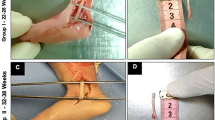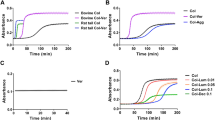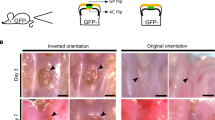Abstract
WHILE it is now generally accepted that the cell plays a dominant part in the fibrogenesis in connective tissues, the mechanism of the formation of the fibrils of collagen and those of elastic tissue and cartilage is completely unknown. The object of this communication is to direct attention to the presence of sub-microscopical filaments in the cytoplasm of fibroblasts, osteoblasts, osteocytes and chondroblasts. The present observations were made with the electron microscope and using ultra-thin sections of tissue.
This is a preview of subscription content, access via your institution
Access options
Subscribe to this journal
Receive 51 print issues and online access
$199.00 per year
only $3.90 per issue
Buy this article
- Purchase on Springer Link
- Instant access to full article PDF
Prices may be subject to local taxes which are calculated during checkout
Similar content being viewed by others
References
Palade, G. F., J. Exp. Med., 95, 285 (1952).
Weiss, P., Arch. Entw. Mech. Org., 116, 438 (1929).
Dalton, A. J., Amer. J. Anat., 89, 109 (1951). Bernard, W., Haguenau, F., Gautier, A., and Oberling, C. H., Z. Zellforsch. u. mikr. Anat., 37, 281 (1952). Sjöstrand, F. S., Nature, 171, 31 (1953). Weiss, J. M., J. Exp. Med., 98, 607 (1953).
Author information
Authors and Affiliations
Rights and permissions
About this article
Cite this article
JACKSON, S. Fibrogenesis in Connective Tissues. Nature 173, 950–951 (1954). https://doi.org/10.1038/173950a0
Issue Date:
DOI: https://doi.org/10.1038/173950a0
This article is cited by
-
Das Zerfallsstadium und die Folgen der Mastzelldegranulierung mit besonderer Ber�cksichtigung der mesenchymalen Reaktion
Zeitschrift f�r Zellforschung und Mikroskopische Anatomie (1963)
-
A histochemical study of the proteins of precollagen fibers in regenerating connective tissue
Bulletin of Experimental Biology and Medicine (1963)
-
Elektronenoptische Untersuchungen an der Gelenkkapsel und ihre Bedeutung f�r die morphologische-funktionelle Einheit des Gelenkes
Archiv f�r Orthop�dische und Unfall-Chirurgie (1962)
-
�ber Alterungsprobleme aus der Sicht der Orthop�die
Archiv f�r Orthop�dische und Unfall-Chirurgie (1962)
-
Ergebnisse der Bindegewebsforschung und ihre Bedeutung f�r Erkrankungen des St�tz- und Bewegungsapparates
Archiv f�r Orthop�dische und Unfall-Chirurgie (1960)
Comments
By submitting a comment you agree to abide by our Terms and Community Guidelines. If you find something abusive or that does not comply with our terms or guidelines please flag it as inappropriate.



